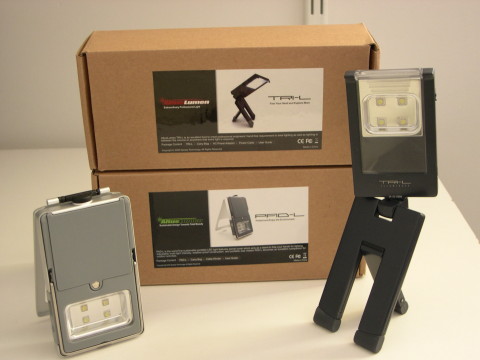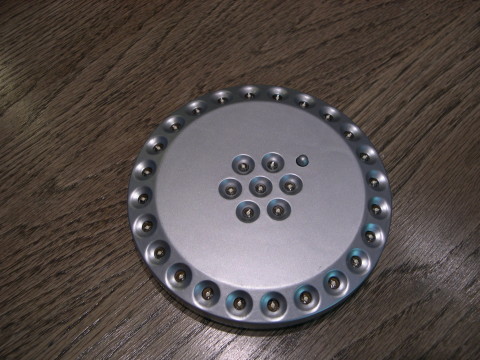
Solar Lighting Field Tests
Field tests in eastern Chad are under way to determine the best solar lighting solution for schools and outdoors literacy classes in refugee camps and villages there. This page will be an ongoing summary of results, which we are sharing not only with supporters of our project, but for the benefit of other aid organizations. We have found very little public literature comparing lights that meet our needs: ultra-portable, rugged, wide-beam for group reading, inexpensive, easy to use and maintain.
For background about the solar lighting component of our Chad/Darfur project, click here.
Update 11/30/09: SOLUX-LED-50 is the winner among these off-the-shelf lighting solutions, and will now be compared to a custom design.
Tests in Chad are conducted by our partner CORD, with lights supplied by us. The following lights have been tested so far:
| model | manufacturer | power source | solar panel | max lumens |
| SOLUX-LED-50 | SOLUX | 3 AA NiMH pack | plug-in | 60-80 |
| Nova S100 | D.light Design | SLA | plug-in | |
| PAD-PRO | AltusLumen | 4 AAA NiMH | none | 180 |
| PAD-L | AltusLumen | 4 AAA NiMH | none | 80 |
| TRI-L | AltusLumen | Li-Ion | none | 55 |
| SunLight SL-2 | SunNight Solar | 3 AA NiMH | integrated | |
| Ecolight | Solarey | supercapacitor | integrated | 50 |
| Hanging Lamp HL-1 | Glenergy | 4 AA NiMH | none |
Prices are not listed since they depend significantly on quantity. Our ultimate deployment will hopefully include hundreds of units.
We may yet test Nemalux's PODLED and CANLED (driven by an external 12V SLA battery) for select installations requiring less portability. We wanted to test, but were unable to obtain, a NiMH-powered version of THRIVE's home light. The light sources in all of the above are LEDs, but vary widely in brightness, beam angle, and efficiency.
Except for the TRI-L, lights lacking a solar panel have been tested with a rollable 10W solar panel from PowerFilm and 8-bay battery charger (T-2680) from Tenergy. The TRI-L's internal Li-Ion battery can be recharged via USB, AC adaptor, or car adaptor, but these options have not been tested in the field.
We are grateful to AltusLumen, Nemalux, Solarey, Tenergy, and Glenergy for donating products for testing.
Before discussing the test results, here are videos of some of the lights, made prior to shipment to Chad:
Not shown in the videos are AltusLumen's PAD-L and TRI-L, and Glenergy's HL-1, which can be seen in the photos below:

AltusLumen PAD-L (left) and TRI-L (right)

Glenergy Hanging Light HL-1
Prior to shipment to Chad, we observed the following about possible strengths and weaknesses of these lights:
SOLUX-LED-50: Compact, lightweight, bright, relatively wide beam, and easy to charge. Not the most compact, lightest, brightest, or widest-beam, but near the top in all categories and, overall, a strong design. Loop for hanging seems like it could break or break away from the ABS plastic body, though. Price seems a little high (but it is made in Germany).
Nova S100: Very rugged, long-lasting light due to the large battery, and easy to charge. However, much heavier and larger than other options, which might be prohibitive.
PAD-PRO: By far the brightest, the widest beam (90 degrees), also the most compact, and among the lightest (with the PAD-L and TRI-L). Will probably be among the least expensive to ship, and may require fewer units because of the brightness and beam angle. Seems to be very rugged (well-sealed metal construction). Flexible means of mounting to a wall, hanging overhead, or standing on a table. However, uses only 4 AAA batteries, so the lifetime might be too short. Also, batteries must be removed to be recharged, which is not ideal for daily use.
PAD-L: Very similar to the PAD-PRO, except for the LEDs, which produce a beam that is a little narrower (although still wide compared to most other lights, at 60 degrees) and much less bright. If this is sufficient, however, the lower cost could make it preferable to the PAD-PRO.
TRI-L: A few differences from the PAD-L, but of primary interest for a comparison are the flashlight mode and ability to recharge without the battery being removed.
SunLight SL-2: Rugged and easy to charge, but the beam might not be bright enough or wide enough, requiring the purchase of too many units. However, the low cost could outweigh this. Unsure whether having an integrated solar panel is an advantage or disadvantage in a refugee camp, as the self-sufficiency might make it a more attractive target for theft.
Ecolight: The singular advantage for our application is that batteries do not have to be replaced after a few years of daily use, because there are no batteries (uses a supercapacitor, instead). This alone makes the light worth testing, since it can be deployed without maintenance potentially for decades. It could justify the higher cost, considering the cost of purchasing and shipping batteries. However, the light might not be bright enough or last long enough. Also, the beam is much too narrow for our application, but the manufacturer indicates that a different reflector can easily be used to produce a wider beam. Might be difficult to mount/hang. Would probably prefer to see the supercapacitor, beam width, and solar panel all enlarged.
Hanging Lamp HL-1: Very inexpensive per unit and relatively few units probably needed because the beam is very wide due to the arrangement of the many LEDs. Also quite compact (disk-shaped) and lightweight for shipping. However, the overall construction does not seem especially rugged, and the battery compartments are quite snug, requiring minor modification with a file (the manufacturer indicates that this defect will be fixed).
The results of ongoing field tests in Chad (last updated 11/30/09):
11/30/09 update:
SOLUX-LED-50 is the winner among these off-the-shelf lighting solutions, and will now be compared to a custom design.
6/26/09 update:
SOLUX-LED-50: Overall leader so far. Bright and long-lasting light. Lightweight enough to be hung from a nail on a wall, and the beam can be directed as needed. Estimated that 6-8 units would be needed per 9m x 5m classroom of 70 people. No problem yet with the ruggedness of the thin hanging loop on the back of the light.
Nova S100: "Easy to charge and lasts forever." Relatively high weight (from the internal sealed lead acid battery) a problem, though, as this will make shipping very expensive, and possibly pose a risk for injury, if the light falls down from being hung overhead (especially, if hung carelessly, as could easily happen). However, the ruggedness could make the light economical in the long-term. If the light weighed half as much and lasted only half as long per charge, it would be more attractive for our application. A lighter weight model is available, but not quite that lightweight. Being further tested in an aid worker's field office as an overhead desk light.
PAD-PRO, PAD-L, TRI-L: Bright enough and wide enough beam, but the light does not last long enough per charge for teaching in schools. Because of other positive characteristics of the PAD-PRO (see above), we have accepted an offer from the manufacturer to develop a modified version with a longer-lasting light and the ability to charge directly from a solar panel. The tripod of the TRI-L is not useful in this application, as lights would probably be hung overhead or from a nail in a wall or post.
SunLight SL-2: Bright enough light, but the AA NiMH batteries supplied with it are of such low capacity that they do not provide a sufficiently long light per charge (no more than 2 hours). Will try higher capacity AA batteries and see if the solar charging time does not become prohibitive. Being further tested in a teacher self-study group in Treguine Camp.
EcoLight: The light is probably not bright enough and does not last long enough. Being further tested in a teacher self-study group in Treguine Camp.
Hanging Lamp HL-1: The light is bright enough and illuminates a large area, but nearly all the five units sent for testing malfunctioned within a few weeks in the field, perhaps due to the extreme heat or dust. Each lamp has 31 LEDs, and individual LEDs progressively failed or units stopped working entirely.
As a result of the testing so far, the top candidates for scaled-up testing prior to a full-scale deployment are the SOLUX-LED-50 and a modified version of the PAD-PRO. However, ongoing tests could change this, especially if units fail due to the harsh environment or rough handling. Each of the other lights probably would be suitable for other applications, just not ours.


